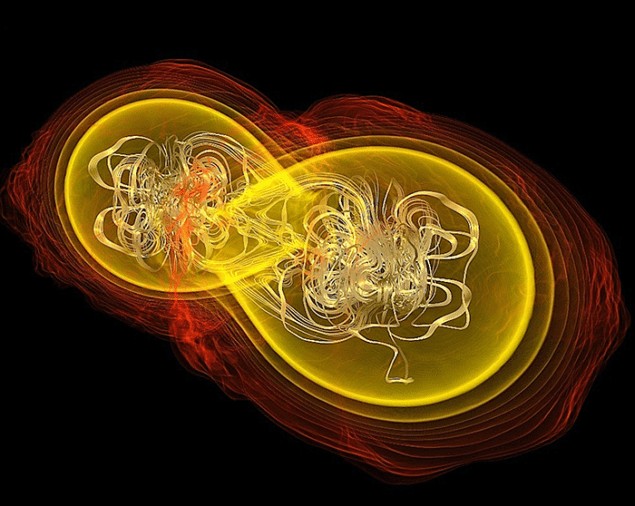Post by 1dave on Apr 12, 2020 12:40:34 GMT -5
physicsworld.com/a/gravitational-waves-reveal-radii-of-colliding-neutron-stars/

Tidal distortion: artist's impression of merging neutron stars. (Courtesy: NASA / AEI / ZIB / M Koppitz and L Rezzolla)
The gravitational waves and electromagnetic radiation detected on 17 August 2017 were produced by the merger of two neutron stars each with a radius of about 11.9 km. That is one conclusion of a new study by astrophysicists working on the LIGO and Virgo gravitational-wave detectors.
Dubbed GW170817, the 2017 event was the first-ever observation of gravitational waves from two neutron stars as they spiralled into each other and then merged to form a black hole. The observation is also notable as the first time that electromagnetic radiation was detected from a gravitational-wave event.
Since the observation, astrophysicists have analysed the detected gravitational waves to gain a better understanding of the properties of the two neutron stars involved in the merger. In May 2018, LIGO-Virgo researchers reported that the merger appeared to have involved neutron stars of different masses. The heavier star is estimated to have been about 1.36-1.60 solar masses, while the lighter star is estimated to have been about 1.16-1.36 solar masses.
Since then, astrophysicists have also tried to calculate the radii of the neutron stars, with a paper published in August 2018 by Soumi De and colleagues estimating that the radii were both about 10.8 km. The calculations were done by considering how the neutron stars could be deformed by each other’s gravitational pull.
Equation of state
Now, LIGO-Virgo researchers have published their own calculations of the neutron-star radii. They also calculated an equation of state (EOS) for the neutron stars – which defines the relationship between the pressure and density of a neutron star.
Read more
Relativistic jet broke through cocoon after neutron star merger
The merger of two neutron stars provides important information about the EOS because the shapes of the neutron stars are distorted by each other’s gravity as they draw nearer. How a neutron star undergoes such a tidal distortion depends on the radius of the neutron star and how easy or hard it is to stretch or compress – the latter being defined by the EOS. This distortion affects both the amplitude and frequency of gravitational-wave emission, and therefore can be deduced from LIGO-Virgo observations.
The latest analysis of GW170817 is based on three important assumptions: that both of the merging objects were neutron stars; that both neutron stars are described by the same equation of state; and that both neutron stars were spinning at rates consistent with other observed binary neutron stars.
The team first calculated the radii of the two neutron stars using a technique that depends only weakly on the EOS. This yielded a radius of 10.8 km for one neutron star and 10.7 km for the other star. In both cases the uncertainty is less than about 20%.
Choice of EOS
In the second analysis, they used an EOS developed by Lee Lindblom and Nathaniel Indik of Caltech in the US. The choice of EOS was guided in part by the 2010 observation of a neutron star with a mass of 1.97 solar masses – the most massive neutron star observed to date. As a result, the EOS chosen by the team must be able to describe neutron stars of this mass and larger. In this case the radii of both the neutron stars was calculated to be about 11.9 km with uncertainties less than 12%.
The analysis is described in Physical Review Letters.











